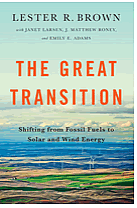The global economy is now undergoing a transition from fossil and nuclear energy to clean power from solar, wind, and other renewable sources, according to the latest book from environmental analyst Lester Brown and his colleagues at the Earth Policy Institute (EPI).
In The Great Transition: Shifting from Fossil Fuels to Solar and Wind Energy lays out the rapidly evolving global shift toward cleaner sources of energy, driven by economics, policy, and the hard realities of accelerating climate change. Brown and co-authors Janet Larsen, J. Matthew Roney and Emily E. Adams, stress that the shift taking place now represents a lasting change in the way we power the world economy.
“The worldwide transition from fossil fuels to renewable sources of energy is under way,” said Lester R. Brown, EPI President and lead author. “As fossil fuel resources shrink, as air pollution worsens, and as concerns about climate instability cast a shadow over the future of coal, oil, and natural gas, a new world energy economy is emerging. The old economy, fueled largely by coal and oil, is being replaced with one powered by solar and wind energy.”
The Great Transition details this evolving trend, focusing on falling prices and rising adoption for wind, solar, electric vehicles, geothermal energy and energy efficiency; and the emerging turn from coal, nuclear power, oil and traditional transportation that is happening faster than anticipated.
Chapter 1 of The Great Transition: Shifting from Fossil Fuels to Solar and Wind Energy is available online at www.earth-policy.org/books/tgt. Supporting data and a PowerPoint summary presentation are available for free downloading.
A few exciting trends:
- The price of solar photovoltaic panels has declined 99 percent over the last four decades, from $74 a watt in 1972 to less than 70 cents a watt in 2014. Between 2009 and 2014, solar panel prices dropped by three fourths, helping global PV installations grow 50 percent per year.
- Over the past decade, world wind power capacity grew more than 20 percent a year, its increase driven by its many attractive features, by public policies supporting its expansion, and by falling costs. By the end of 2014, global wind generating capacity totaled 369,000 megawatts, enough to power more than 90 million U.S. homes.
- National and sub-national policies around the world are shifting to support renewables and put a price on carbon. These include 70 countries with feed-in tariffs; two dozen countries with renewable portfolio standards (RPS); 37 countries with production or investment tax credits for renewables; and some 40 countries implementing or planning carbon pricing.
- U.S. coal use is dropping – it fell 21 percent between 2007 and 2014 – and more than one-third of the nation’s coal plants have already closed or announced plans for future closure. Meanwhile the Stowe Global Coal Index – a composite index of companies from around the world whose principal business involves coal – dropped 70 percent between April 2011 and September 2014.
- For the world as a whole, nuclear power generation peaked in 2006, and dropped by nearly 14 percent by 2014. In the US, the country with the most reactors, nuclear generation peaked in 2010 and is now also on the decline.
- In China, electricity generation from wind farms now exceeds that from nuclear plants, while coal use appears to be peaking.
“The energy transition amounts to a massive restructuring of the global economy,” the authors write. “Initially this energy transition was driven by government incentives, but now it is also being driven by the market. With the market today favoring both solar and wind energy in many locations, the transition is accelerating, moving much faster than anticipated.”
“We are all stakeholders” in the Great Transition, the authors conclude. “In the broadest sense, everyone who breathes cleaner air, drinks cleaner water, and benefits from a more stable climate will come out on top as the energy transition proceeds.”
Contact for additional information:
Lester R. Brown, Author & President (202) 496.9290 x 11, [email protected]
Janet Larsen, Co-author & Director of Research (202) 496.9290 x 14, [email protected]
J. Matthew Roney (202) 496-9290 ext. 17 | [email protected]
Earth Policy Institute is a research organization dedicated to planning a sustainable future and providing a roadmap of how to get from here to there. More on EPI available at earth-policy.org.
Data and additional resources available at www.earth-policy.org.



